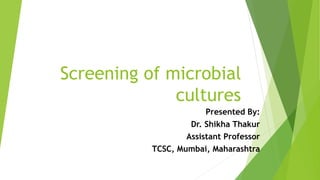
Screening
- 1. Screening of microbial cultures Presented By: Dr. Shikha Thakur Assistant Professor TCSC, Mumbai, Maharashtra
- 2. Screening – It refers to the isolation of only those microorganisms which are of interest from among a large population of microbes. They are mainly of two types: Primary and Secondary Screening Primary Screening : The effective screening must in one or few steps which allow the discarding of many valueless microorganisms, while at the same time allowing the easy detection of the small percentage of useful microorganisms that are present in the population. Secondary Screening : As primary screening allows detection and isolation of microorganisms that possess potentially interesting industrial applications. This is usually followed by a secondary screening to further test the capabilities of and gain information about these organisms.
- 3. Types of Primary Screening Crowded-plate technique – Natural microbial source such as soil is diluted to provide a cell concentration such that aliquots spread, sprayed or applied in some manner to the surfaces of agar plates will yield colonies not touching neighbouring colonies. An alternative procedure for detecting organic acid production involves incorporation of calcium carbonate in medim so tht organic acid production is indicated by cleared zone of dissolved calcium carbonate around the colony. Screening approach has also been employed extensively in search for the microrganisms capable of producing useful antibiotics. The simplest screening technique for antibiotic procedures is the “crowded plate” procedure. Colonies producing antibiotic activity are indicated by an area of agar around the colony that is free of growth of other colonies. Such a colony is subcultured to a similar medium and purified by streaking before making stock cultures.
- 5. Improvement of crowded technique Antibiotic screening is improved, therefore, by incorporation into the procedure of “test organism”, that is an organism us as an indicator for the presence of specific antibiotic activity. A suspension of test organism is then sprayed or applied in some manner to the surface of the agar, and then plates are further incubated to allow growth of the test organism. When volatile substrates such as hydrocarbons, low molecular weight alcohols, and similar carbon sources are being considered. The dilutions from a microbial sources are applied to plates of agar media containing all nutrients but the specific substrate and the specific substrate is placed in the lid of petriplate after inversion of the plate. Enough vapours from the volatile substrate rise to the surface of the agar within this closed atmospheric to provide the specific nutrient for the microorganism.
- 6. Secondary Screening Secondary screening allows the further sorting out of those microrganisms that have real value for industrial processes and discarding of those lacking this potential. Secondary screening is conducted on agar plates, in flasks or small fermenters containing liquid media, or combination of these approaches. Liquid culture provides a much better picture of the nutritional physical, and production of responses of an organism to actual fermentation production conditions.
- 7. Secondary screening can be qualitative and quantitative in its approach Qualitative approach – eg. Spectrum or range of microorganisms which is sensitive to a newly discovered antibiotic. Quantitative Approach – This tells us about the yields of antibiotic which can be expected when the microorganism is grown in various differing media. Secondary screening should yield types of information which are needed in order to evaluate the true potential of a microorganism for industrial usage. Secondary screening should determine whether a more economical process is possible. To determine whether a product actually is newly discovered sompound, we can utilize paper, thin layer or other chromatographic procedures to compare the product with known compounds. Secondary screening should detect real differences in product yiels potentials among various isolates.
- 8. Secondary screening should reveal whether there are pH, aeration, or other critical requirements associated with particular microorganisms, both for the growth of the organism and for the formation of chemical products. Screening should show whether certain medium constituents are missing or possibly are toxic to growth of the organism, or its ability to accumulate fermentation products. It should show something of chemical stability of the product and product solubility. It should determine whether the product has simple, complex, or even a macromolecular structure. It should show whether the product possesses physical properties such as U.V. light absorption or fluorescence, or chemical properties that can be employed to detect compound.
- 9. Certain kinds of fermentation products, determinations should be made as to whether gross animal, plant or human toxicity can be attributed to the fermentation product, particularly if it is to be utilized in disease treatment. Secondary screening should reveal whether a product resulting from a microbial fermentation occurs in the culture broth in more than one chemical form, and whether it is an optically or biologically active material. Secondary screening should reveal whether microorganisms are able to chemically alter or even destroy their own fermentation products. Thus, a microorganism might produce a “racemase” enzyme that will change the L- configuration of an amino acid product to a mixture of the D and L- isomer of being little biological value.
- 10. Thank You
